Lauric acid or systematically, dodecanoic acid, is a saturated fatty acid with a 12-carbon atom chain, thus having many properties of medium-chain fatty acids, is a bright white, powdery solid with a faint odor of bay oil or soap. The salts and esters of lauric acid are known as laurates.

The red-rumped agouti, also known as the golden-rumped agouti, orange-rumped agouti or Brazilian agouti, is a species of agouti from the family Dasyproctidae. It is native to northeastern South America, where found in Venezuela, Guyana, Suriname, French Guiana, northeastern Brazil, and Trinidad and Tobago. It has also been introduced to the U.S. Virgin Islands, Grenada, and Dominica. Despite the alternative name Brazilian agouti, it is neither the only nor the most widespread species of agouti in Brazil. In Brazil all agoutis are often called "cutia" [kuˈtʃiɐ].

Güeppi-Sekime National Park is a protected area located in the Peruvian region of Loreto, on the border with Ecuador. The park encompasses 203,628.51 hectares (2,036 km2) of forests in a landscape that features hills and seasonally flooded lowlands.
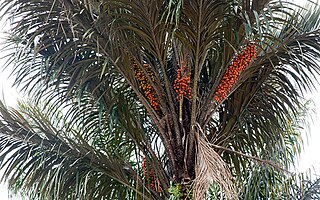
Astrocaryum vulgare is a palm native to Amazon Rainforest vegetation, typical of the Pará state in Brazil. This plant has edible fruit, which are also used for biodiesel production. This plant is cited in Flora Brasiliensis by Carl Friedrich Philipp von Martius. This species is native to the Amazonian region, possibly to the state of Pará, where it has its center of distribution, and reaches French Guiana and Suriname. It is a characteristic palm of terra firme, low vegetation cover, or even open fields. The tree is 10–15 m (33–49 ft) in height and regenerates easily by growing multiple stems. The tucumã palm is considered a pioneer plant of aggressive growth, has the ability to grow new shoots after a fire, and mainly inhabits secondary forests and pastures. Seeds take up to two years to germinate, the plants grow slowly in cultivation, and start to produce fruits after eight years. Its resistance to diseases and high productivity make this species an alternative for the production of biodiesel, since the operating costs of an orderly plantation is much less than that of the oil palm.

Astrocaryum is a genus of about 36 to 40 species of palms native to Central and South America and Trinidad.
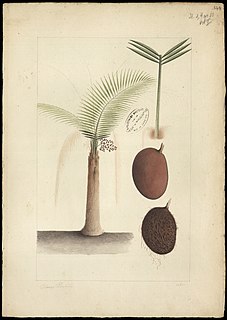
Leopoldinia piassaba, the Para piassava, piassava fiber palm or piassava palm, is a palm native to black water rivers in Amazonian Brazil and Venezuela, from which is extracted piassava, a high caliber and water resistant fiber. Piassaba fiber is made into brooms, baskets, and other products. This plant is also a natural habitat of the Rhodnius brethesi, which is a potential vector of Chagas disease, and it is cited in Flora Brasiliensis by Carl Friedrich Philipp von Martius.

Astrocaryum murumuru is a palm native to Amazon Rainforest vegetation in Brazil, which bears edible fruits. Murumuru butter, extracted from the seeds of the plant, may be used as a moisturizer.
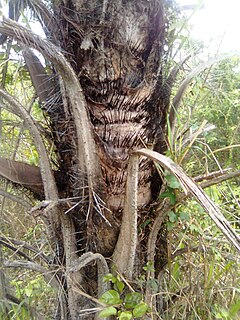
Astrocaryum jauari is the most frequently encountered palm native to Amazon Rainforest vegetation in the floodplains of the Rio Negro, in Brazil. Its fruits are edible. This plant has further commercial value because it may be used in the production of heart of palm.
Astrocaryum ferrugineum is a palm native to Amazon Rainforest in Brazil.
Astrocaryum faranae is a palm native to Amazon Rainforest vegetation in Brazil and Peru. This plant has a commercial value because it has oil seeds which may be used to make cosmetics.
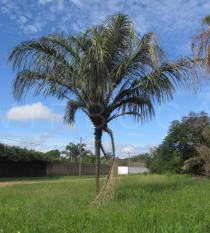
Astrocaryum aculeatum is a palm native to tropical South America and Trinidad. It grows up to 15 m (49 ft) tall and is usually solitary. It has ascending leaves, erect inflorescence, and yellow fruit.
Maria Grace Fadiman is an American ethnobotanist and Professor of Geosciences at Florida Atlantic University.

Astrocaryum alatum, the coquillo or coquito, is a species of flowering plant in the family Arecaceae. It is found in Costa Rica, Nicaragua, and Panama. It is threatened by habitat loss.
Astrocaryum minus is a species of flowering plant in the family Arecaceae. It is found in Brazil and French Guiana. It is threatened by habitat loss.
Astrocaryum triandrum is a species of flowering plant in the family Arecaceae. It is found only in Colombia. It is threatened by habitat loss.
Astrocaryum urostachys is a species of flowering plant in the family Arecaceae. It is found only in Ecuador. Its natural habitat is subtropical or tropical moist lowland forests.

Pucacuro National Reserve is a protected area in Peru, located in the region of Loreto.
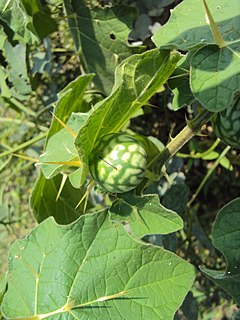
Solanum aculeatissimum, known as Dutch eggplant, and love-apple, is a weedy shrub that bears small, 2–3 cm pale yellow fruit following white flowers with characteristic Solanum yellow stamens.

Astrocaryum standleyanum is a species of palm known by many common names, including chumba wumba, black palm, chonta, chontadura, coquillo, palma negra, pejibaye de montaña, güerre, güérregue, güinul, mocora, pucaishchi (Chachi), and chunga (Emberá). It is native to Central and South America, where its distribution extends from Nicaragua to Ecuador. It is most common in central Panama, even becoming "abundant" in the tropical forests around the Panama Canal, but in general it is not a common plant.











